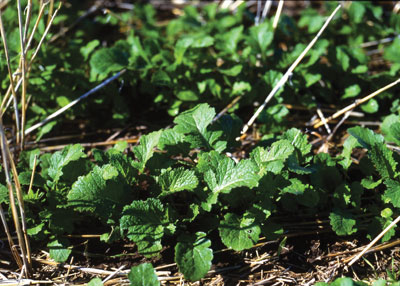
Features
Agronomy
Corn
Mustard production is hot
Mustard is well suited to the Brown and Dark Brown soil zones of Western Canada and can be a good oilseed crop to include in a crop rotation.
November 21, 2011 By Donna Fleury
Mustard is well suited to the Brown and Dark Brown soil zones of Western Canada and can be a good oilseed crop to include in a crop rotation. Canada is one of the largest mustard exporters globally, with about 80 to 90 percent of Canadian production produced in Saskatchewan. In Alberta, acreage ranges between 60,000 and 120,000 acres annually.
 |
|
| Mustard can be a very good economic alternative in the Brown and Dark Brown soil zones. Photo by Bruce Barker.
|
Mustard is a relative of canola, but tends to be more tolerant to drought, heat and frost. “For growers in the Brown and Dark Brown soil zones in drier years, mustard crops will tend to be more drought tolerant and can be a very good economic alternative versus canola,” says Dr. Ross McKenzie, research scientist, agronomy, with Alberta Agriculture and Rural Development (ARD) in Lethbridge. “In wetter to normal years, canola will do well in the Brown and Dark Brown soil zones and may be more profitable than mustard. For growers in areas where moisture conditions are generally better, such as the Black soil zone, canola is probably a more profitable crop to grow.”
There are three types of condiment mustards that can be grown in the southern Prairies: including yellow (Sinapis alba), brown and oriental (Brassica juncea). All three are more drought and frost tolerant than canola, allowing for early seeding. There are different varieties available for each type of mustard. One of the best yellow mustards is AC Pennant, an AAFC variety that yields quite well.
Selection of mustard type is often based on expected price, yield potential and the requirements of the contracting company.
One big benefit of mustard over canola is mustard’s tolerance to cabbage seedpod weevil, which is a major pest of canola that most southern Alberta farmers regularly spray for. Yellow mustard is completely resistant to cabbage seedpod weevil, while brown and oriental types have some tolerance.
Mustard is susceptible to other insect pests such as flea beetle, and is susceptible to similar canola diseases. Canola, safflower, sunflower, flax, pea, lentil, chickpea and dry bean should not be grown one to two years before mustard in a crop rotation, as they have common disease problems, specifically sclerotinia.
“Growers can typically use a similar fertilizer package for mustard as they would use for canola for that same farm and that same field,” explains McKenzie. “Although the yield potential may not be quite the same, when moisture conditions are good mustard will actually yield very well.” All mustard types are very sensitive to insufficient N and are very responsive to N fertilization when available soil N levels are low. Side-band or mid-row band N fertilizer at the time of seeding at optimum rates to target optimum production and seed placement of safe rates of phosphate fertilizer are important. In sulphate-deficient soils, sulphate fertilizer is required to ensure optimum yield. Mustard is extremely sensitive to seed-placed fertilizer; therefore, great care is needed to not apply too much fertilizer with the seed.
One of the challenges of growing mustard is the more limited range of registered herbicides for weed control. “Therefore weeds can become more of an issue in mustard production than for herbicide-tolerant canola production,” says McKenzie. “For in-crop control, it is important to note that the herbicide ethalfluralin (e.g., Edge) is only registered for use with yellow mustard and that ethametsulfuron methyl (e.g., Muster) is only registered for use with brown and oriental mustard.”
Remember that yellow mustard is in the Sinapis alba family, and brown and oriental mustard are in the Brassica juncea family; therefore, growers must check product labels and lists of registered herbicides carefully. Controlling weeds early is important to reduce weed competition.
Ensuring optimum weed and volunteer canola control in mustard is important to achieve the highest market grade, lowest dockage and highest net financial return. Weed seeds such as cow cockle, cleavers, wild mustard, wild buckwheat and volunteer canola are difficult to remove from mustard seed, can cause high losses during seed cleaning and will lower market grades. “Therefore, land used for mustard production should be free from these problem weeds,” explains McKenzie. “In addition, growers should not grow canola and mustard in the same field to prevent volunteers and contamination.” Even a one percent level of canola volunteers in mustard can cause the crop to be rejected. Therefore, if growers are growing both crops, there should be at least four years between crops to ensure any volunteers have been removed.”
“Mustard is a great crop to grow for several reasons and for farmers in the Brown and Dark Brown soil zones it is probably a better choice than canola over the long term,” says McKenzie. “A good four-year rotation could include wheat, mustard, barley and peas. Growing mustard as the oilseed in that rotation is a good fit and can provide good economic returns and other benefits.” For more information on mustard production, see the Alberta Agriculture Agdex publication by McKenzie: Mustard production in Alberta Agdex 143/20-1.
Online at www1.agric.gov.ab.ca/$department/deptdocs.nsf/all/agdex12947